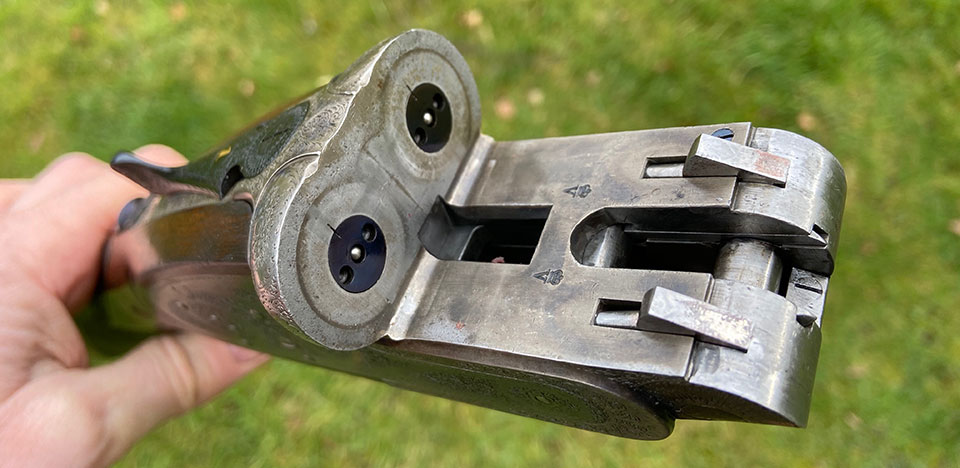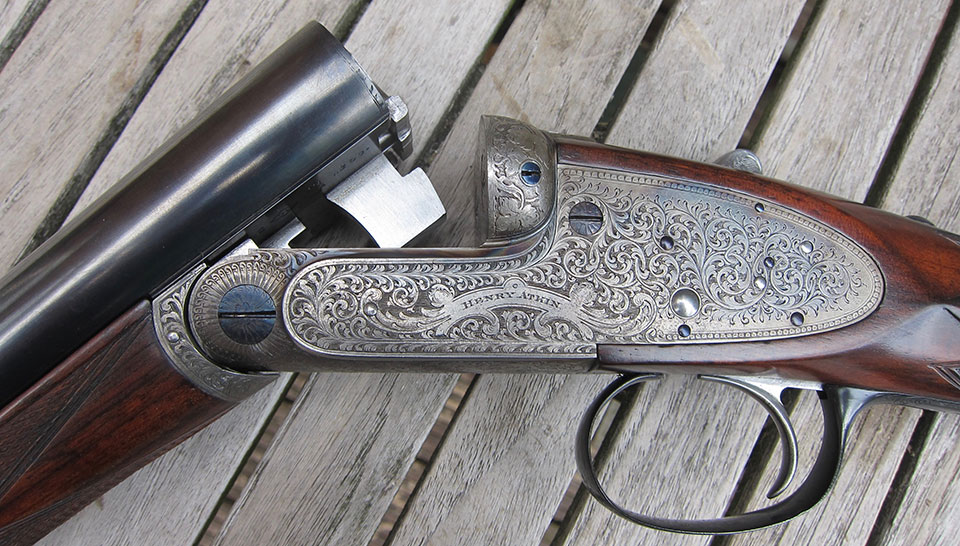The classic sidelocks made by Purdey and Atkin are more complex and sophisticated than the self-opening systems used by other firms. The main springs not only force the gun open, but they also cock the tumblers and fire the gun.
We should, in fairness, make clear that the inventor of the guns under discussion was a certain Frederick Beesley. His 1880 patent (No.31) was bought by James Purdey the Younger in August of that year for £55, who built the first as a .450 non-ejector double rifle. Thereafter, it became Purdey's house style of 'best' gun and has been justly famous ever since. The Beesley patent showed no ejectors.
The essence of the Purdey and the Atkin lies solidly in Beesley's patent drawings but both have undergone modification over the years. The action is ingenious and was unlike anything else on the market when conceived. Rods projecting through the action bar are pressed backwards by pads connecting with the barrel flats when the gun is closed.
These push a cam, which puts the mainspring under tension. When opened, the mainspring reverses the tension and puts pressure on the barrel flats, via these rods, and forces the gun to jump open. The force of the mainspring therefore, enables a Purdey to be fully opened with the right hand only, while the left is free to pick up cartridges, thereby speeding up the loading cycle. When disassembled, the springs are under very little tension.

After the gun has been fired, this opening action causes the top arm of the mainspring to cock the tumbler as it moves upwards. This is why the Beesley is known as a 'spring cocking' sidelock. Conventional sidelocks, like the Holland & Holland 'Royal' and the Boss, are cocked by cocking levers, which lift the tumblers as their forward ends hinge downwards when the barrels fall open.
The only real criticism of the action, made vocally by WW Greener and, doubtless, others, was that it was hard to close. James Purdey did not think it a problem. Neither do I, for that matter. The trick is to rest the stock on the hip, hold well forward and close with a smooth push. Once mastered it is automatic and natural. However, the criticism persisted.
Henry Atkin first sold a Beesley action sidelock in 1907 (actually a pair) but then reflected on the common perception that the Purdey was difficult to close. The subsequent alterations became encapsulated in the Atkin '1909 Model' which became his signature sidelock and remains so to the present day. In 1909, the firm was under the stewardship of managing director Charles Frederick Hinton, a nephew of founder Henry Atkin. Arthur Hodges provided the gun making expertise.
Two avenues of improvement were open to exploration. The first was the sequence of internal movements required to tension the mainspring when the gun was closed and the second was the ejector mechanism. It is noteworthy that ejectors have springs and they have to be put under tension either upon opening or closing the gun. This operation requires energy as well.
The first Purdey ejector was a coil spring type, patented by Nobbs in 1883 but this was replaced by the Wem system in 1888, with its distinctive bow tie shaped crossbar at the knuckle (from around S.N 14,000). This was prone to fail after prolonged use and the 1930s saw the introduction of the Lawrence ejector variation, with its centre-arm, which has been used ever since.
So, what did Atkin's come up with to improve the Beesley and create their own classic? Michael MacIntosh describes the difference as 'changing the lock cams and ejector system a bit'. Perhaps it is time to examine exactly what those changes are and what effect they have. It does not help that no patent exists for the modifications, as they are just that, rather than new concepts.

Alterations to the cocking mechanism.
Atkin decided to attempt to soften the 'hard closing' reputation of the Purdey. To do so, attention had to be paid to the parts operating the chain of motion from barrel flats to mainspring. When checking a Purdey or an Atkin spring opener today, one needs to pay attention to the closing procedure. If not properly set up, the gun can feel like it has tight spots. If correctly done, it will feel progressive and smooth. The Atkin lock cam is slightly broader and more roundly profiled.
Alterations to the ejector work
In fairness, we should compare the Atkin ejector work with the system which was its 1909 contemporary. Atkin ejector rods work off a long limb, roughly the shape of a spanner, which is connected to the main sear. When the gun is fired, the forward end of this limb holds the ejector rod forward so that it can trip the ejector.
The Purdey has a turret on the tumbler, which fits into the reverse 'D' of the ejector rod. Upon firing, the turret moves forward and holds the ejector rod forward so that it can trip the ejector by pushing the side springs out of the way. The Atkin ejector is a simpler Southgate type with each ejector trip pushing the cam past its firing point.
In 1947 G.T Garwood took delivery of his new Atkin 1909 model 12-bore. Better known as 'Gough Thomas', Garwood was the doyen of shooting writers at the time, having had a long period as gun editor of the Shooting Times. He was delighted with his Atkin and stuck with it for the rest of his life. He commented; "I am particularly pleased with the smoothness of opening and the uniformity of the effort required to close it... there are no hard spots, which is more than i can say for some self-openers".
Henry Atkin and James Purdey are names which can still be found on new guns with Beesley heritage. It reflects well on all three that the quality of the guns and the genius of the concept have withstood the ravages of time and stand proud as the best of their type. They prove that a complex action can remain efficient and reliable for over a century.
The key to making Beesley's action work is to make all the shapes right. There are so many inter-related movements, each reliant on the previous one being as smooth and balanced as possible, that stiffness from poorly shaped or angled parts will magnify the difficulty of moving them all. The Atkin ejector system does seem to allow the whole operation to feel a little smoother.
This is really why Purdey and Atkin models are offered by so few firms. To be able to make one, you really have to be fabulously skilled and the work has to be carried on without cost-cutting on labour or materials. They are expensive to make. If you make one badly it will be horrible. Make one perfectly and there is not a better game gun in the world. It will function beautifully and faultlessly for generations, despite its complexity.
Published by Vintage Guns Ltd on (modified )



